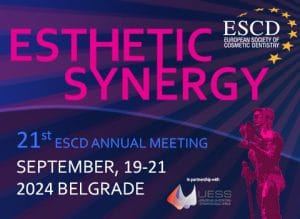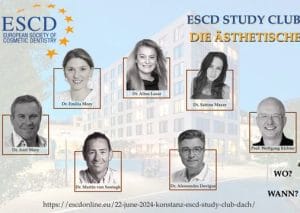Esthetic Objectives: Achievements and Potentials
Sep 25-17, 2009, Paris
Download PROGRAM in PDF
Dental Pearls and… Dancing Girls!
Philip Lewis Attends the 6th Annual Conference of the European Society of Cosmetic Dentistry in Paris
September in Paris. The leaves on the trees turn to glorious autumnal shades while the still warm sunshine reflects from the river onto fine buildings and elegant boulevards. The outstanding beauty of one of Europe’s favourite Capitals formed a perfect backdrop to the outstanding beauty created and displayed by some of the world’s finest clinicians and dental technicians at the 2009 ESCD Annual Conference.
Lecturers from Europe and beyond treated delegates to information and practical training during the 2-day meeting. Opening as usual with ‘Members’ Pearls’ the session included information from Dr. Michael Karlsten on predictable bite registration with implant- supported bridges while Dr. Ajay Kakar demonstrated aesthetic splinting techniques for compromised teeth using quartz glass materials which by virtue of their low elastic memory were easy to place and adapt.
After the official opening by ESCD President Dr. Wolfgang Richter and Dr. Jean-Paul Djian it was time for Dr. Irfan Ahmad to discuss dilemmas and solutions in clinical cases. Beginning with an overview of caries pathogenesis and the role of biofilm the lecturer went on to challenge existing paradigms and suggest that treatment should be based on risk assessment. He continued by describing a method of resin infiltration to prevent the progression of early carious lesions as part of a micro- and minimally-invasive treatment regime.
The coffee break gave delegates a chance to renew old acquaintances and make new friends. Many countries in Europe have their own dental cosmetic societies but ESCD members have the advantage of being able to talk and discuss approaches in dentistry across the whole of the continent. This expands horizons for everyone and is a valuable benefit of belonging to the Society.
Dr. Nik Sisodia’s ‘Strategies for Successful Implantology in the Aesthetic Zone was the first in a series of lectures given throughout the Conference that were invaluable to the serious implantologist. Looking at emergence profiles, bone preservation and augmentation, implant positioning, abutments and the use of the ovate pontic the lecturer addressed many of the potential difficulties in creating excellent aesthetics.
Chairside CAD-CAM was the subject for Dr. Christian Moussally. Looking at direct and indirect techniques the speaker pointed out the advantages of single-visit treatments with a description of protocols as well as a frank discussion of the drawbacks.
Accomplished speaker Professor Edward Lynch continued the theme of minimal intervention with emphasis on the use of ozone and ozonised water. The powerful disinfectant properties of ozone are useful throughout a range of dental procedures from hand-washing to caries limitation. As the only method of reliably destroying prions on dental instruments the use of ozone may have far-reaching health benefits. Professor Lynch described delivery systems and treatment modes; encouraging all practitioners to explore this area of dental therapeutics.
Janson concentrated on colour perception as influenced by surrounding structures and the understanding ofcolour gradients. These ideas were applied the following day in a hands-on workshop where delegates learned new techniques while placing an aesthetic class 4 composite.
Dr. Marvin Fier explained the use of illusions as an aid to aesthetics, for example by repositioning labial proximal ridges when ideal anatomic forms cannot be achieved.
It was late in the afternoon when the final sessions of the first day began. ESCD makes the most of the time available for education but gives delegates the opportunity to work hard and then play hard!
Dr. George Kirtley looked at smile design concepts and the restoration of harmony, especially with the use of porcelain veneers; then Dr. Jean-Pierre Attal closed the lectures with his presentation on adhesive dentistry. Stressing the superior survival of cantilever bridges as opposed to fixed-fixed the lecturer never the less recommended the latter in cases of traumatic occlusion or if retainer function was needed. He discussed the advantages of combining restoration with orthodontics and described the technical demands of pontics and retainers.
While the lectures were underway Member Certification sessions were going on elsewhere. ESCD offers members the chance to display their commitment to cosmetic dentistry by presenting clinical cases and other evidence for scrutiny by a panel of experts. Successful candidates are awarded Certification which is promoted on the Society’s website. In addition the Society is co-ordinating a recognised Master of Science degree which was explained in a further session.
Afternoon workshops included the management of mobile and migrating teeth as well as the connections between medicine and dentistry; new materials and techniques.
ESCD is famous for its entertainments and this meeting was no exception! A quick change of clothes then of to the buses for the short journey to the Latin Quarter to enjoy an authentic Parisian Cabaret. Superb food and freely flowing wine enhanced the enjoyment of a show packed with action, breathtaking speciality acts and of course, lots and lots of dancing girls!
On the second day I attended the limited-attendance workshops; sadly missing the lecture presentations on treatment-planning, composite artistry, the aesthetics of the aging smile and risk factors in aesthetic dentistry.
My choices included Dr. Kirtley’s presentation on veneer design, construction and cementation which included advise on patient management, marketing and the use of photography and imaging.
Later in the day Professor Dr. Martin Joergens and Professor Dr. Marcel Wainwright hosted a fascinating session discussing the use of high technology equipment. Different types of lasers are appropriate for applications including wound-healing, soft and hard tissue surgery, sterilisation of cavities and root canals and in periodontics. Piezo instruments and 3D radiographic imaging were among the other topics considered. An innovative bone augmentation technique using a tunnel preparation combined with a commercially available denatured bovine bone was shown. After the presentation delegates were able to examine and try out some of the equipment for themselves.
The lunch and refreshment breaks were times when delegates could visit the trade exhibition which accompanied the meeting. Suppliers offered products ranging from educational materials to laboratory services. Workshops ended at the final coffee break but the lectures continued for almost another 3 hours.
International lecturer Dr. Bernard Touatti asserted ‘transmucosal biocompatibility is the key to success’. Looking at the position and shape of the papilla, the colour of the gingivae and other factors he described a simple scoring system to assess aesthetic success. Following with a description of bone augmentation and a discussion of ovate pontics, abutments, radiographic tomography and implant positioning this comprehensive lecture was well-received by all delegates. Bone augmentation is often important in achieving implant success and exciting developments have been made over recent years. One of the latest was described by Pr. Sacha Javanovic using a live web link from UCLA in Los Angeles. Bone morphogenetic protein 2 converts stem cells to osteoblasts and can now be produced in commercial quantities. Its use in collagen strips confined by a titanium mesh produces trabecular and vascular new bone in a period of about 6 months. At present only approved for use in the United States this remarkable illustrated lecture gave delegates a preview of a treatment that will almost certainly revolutionise treatments throughout the world.
Ever had a round of applause for placing a suture? Dr. Thierry Degorce did after his elegant video showing the inversion of a gingival flap as part of a soft-tissue augmentation procedure. Sometimes combined with hard tissue augmentation his technique using palatal free gingival grafts produced impressive aesthetic results.
Time to play again! The educational programme over, delegates once more headed into town to join an evening boat cruise on the Seine. More food, drink, dance and revelry was followed (for the energetic ones) by a trip to a famous night club where the partying went on into the early hours. Those who hadn’t celebrated too much at the party rose to attend the ESCD General Assembly the next morning where elections were held for the new Executive Committee. This Committee will take the Society forward over the next 3 years building on previous success to make ESCD even more beneficial to its members in the future.
ESCD’s 6th Annual Conference was another tour de force of educational delight as well as a hugely enjoyable social event. Well-organised and varied, the programme offered something for everyone with an interest in the dental cosmetic field. Delegates left feeling motivated and eager to introduce some of the new ideas they had learned into their practices.
[su_custom_gallery source=”media: 31822,31823,31824,31825,31826,31827,31828,31829,31830,31831,31832,31833,31834,31835,31836,31837,31838,31839,31840,31841,31842,31843,31844,31845″ limit=”24″ link=”image” width=”200″ height=”200″ title=”never”]





